14 Foods That Are Better When You Start With A Cold Skillet
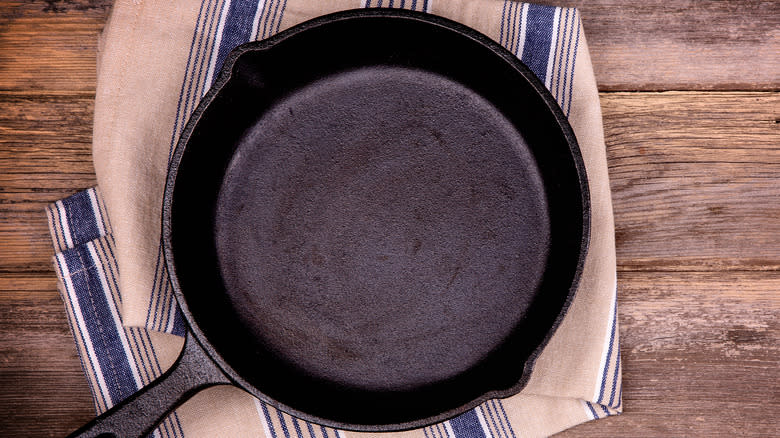
There's little use in a cold skillet, and for most recipes, heat is the name of the game. However, heating your skillet to a searing temperature before dropping your food onto it may not always give you the best results. For certain foods, beginning with an ultra-hot skillet can be the worst move you can make, causing your ingredients to scorch, burn, or overcook quickly. Contrary to what logic might tell you, starting with a cold skillet can produce a more even, tastier result.
Cyrille Holota, the executive chef at Le Bibloquet at Buckhead Village in Atlanta, Georgia, agrees. "Starting with a cold skillet can be advantageous for certain cooking techniques, such as cooking delicate foods like fish or eggs," he says. "It allows for more control over the cooking process, preventing overheating and getting an even cook." What might surprise you, too, is the number of foods where beginning with a cold skillet is more beneficial than using a hot one straight off the bat. We decided to investigate which foods were better with a cold skillet, and with some vital contributions from Holota, we present to you our top picks.
Read more: French Cooking Tricks You Need In Your Life
Nuts
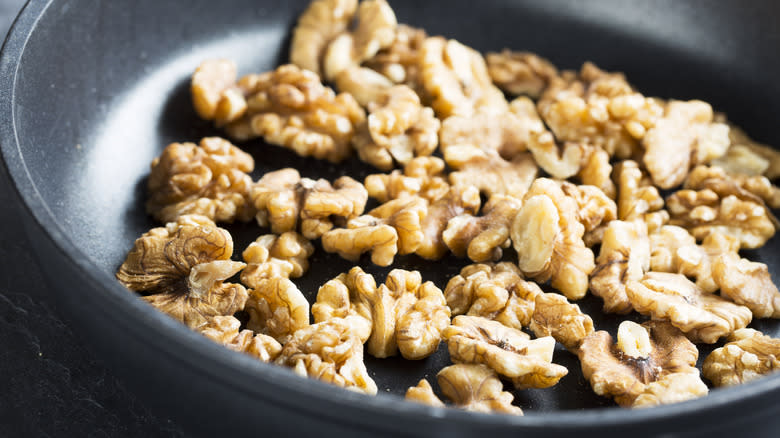
Toasting nuts in a skillet is one of the best ways to intensify their flavor. When you toast nuts, you usher in the Maillard reaction, creating additional tastes and aromas and dialing up their complexity. Starting with a hot pan to do this, however, is a risky game. "When your skillet is too hot, nuts can easily burn and have a bitter aftertaste," Cyrille Holota warns. Nuts are high in fat, which can cause their surfaces to cook super quickly, and if you're not careful, you'll ruin them.
Instead, Holota recommends using a cold skillet. "Starting with a cold skillet when toasting allows more control over the toasting process; you can gradually heat the nuts, ensuring even toasting without the risk of burning while you move them at the same time," he says. "It may take a little longer, but you will have a better and even golden color." This is as true for larger nuts like cashews or healthy Brazil nuts as it is for smaller ones, like pine nuts. The same goes for seeds: Pouring tiny sesame or sunflower seeds into a hot pan can cause them to scorch instantly, whereas starting with a cold skillet can help you manage how quickly they brown.
Fried Eggs
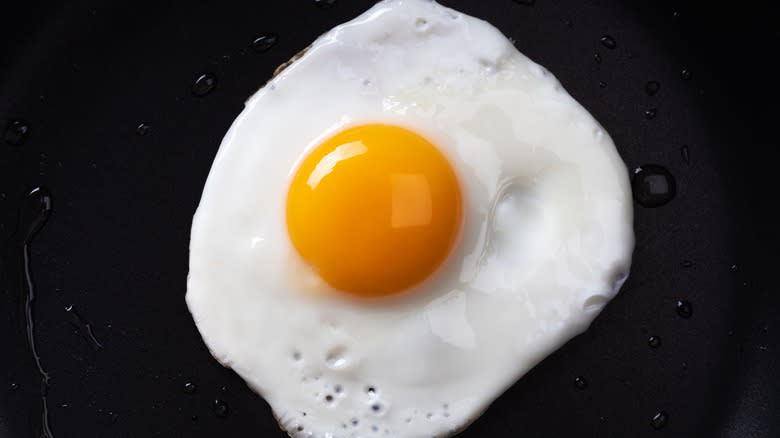
We understand why this one might surprise you -- after all, most people's mental image of a fried egg is one that bubbles up immediately after hitting a searing-hot skillet. Starting with a cold pan, however, will produce an overall more tender result. When you drop an egg into a hot skillet, the egg white's bottom and edges cook nearly instantly, while the top of the egg and the yolk stay loose. Unless you're willing to bravely flip your egg, you then have to wait until it cooks through to its upper surface, and this can cause the whites to become tough and rubbery.
Starting with a cold skillet can help you avoid all this. Pour a little oil into your pan and spread it around, before cracking your egg on top. Then, allow everything to heat on medium-low. Your egg white will gently cook, keeping it tender, and you'll end up with a soft fried egg that's perfectly cooked through. It's a good idea to use a smaller skillet with this method, to stop your egg from spreading too much.
Butter
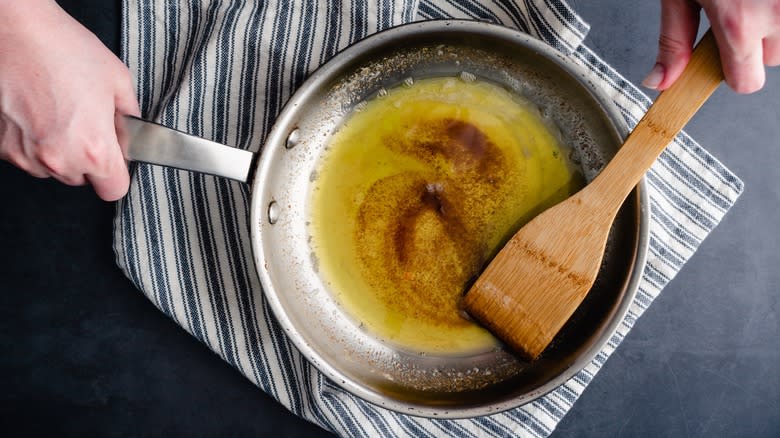
Browning butter unlocks an extraordinary amount of flavor in everyone's favorite fat. Regrettably, too many people go about it the wrong way and start with a hot skillet instead of a cold one. Butter is particularly prone to scorching due to its high amount of milk solids, which are super sensitive to heat and can cook unevenly as they melt and spread out. This can cause the butter to burn quickly in a hot pan, becoming bitter and overly dark, says Cyrille Holota.
Avoid this by keeping things cool. "Starting with a cold skillet when browning butter allows for the butter to control the melting process," Holota states. "By starting with a cold skillet, you can gradually melt the butter and allow the milk solids to separate and brown evenly, without the risk of burning; you will get a beautiful nutty Beurre Noisette." Once you have your browned butter, you can use it to add deep flavor to foods instantly, and it's equally at home on pasta or gnocchi as it is poured over a sandwich. If you love brown butter, you also need to try whipping it, which will give it a thick, spreadable consistency.
Garlic
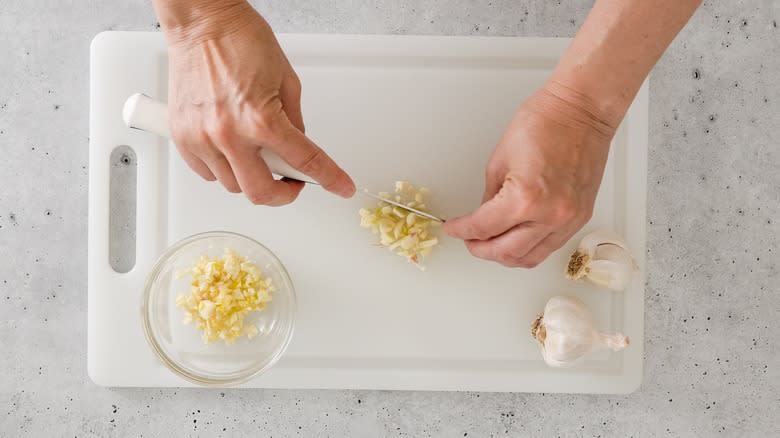
Few foods cook as quickly as garlic, and few foods become as bitter and horrible-tasting once burnt. Garlic burns so quickly thanks to its combination of a low water content and a higher quantity of sugars. Because there's little moisture to cushion the sugars when they interact with heat, they brown and burn faster. Combine this with the fact that garlic is usually minced or chopped into fine pieces, which cook quicker, and it's a recipe for disaster.
Despite this, almost everyone we know throws their garlic into a sizzling skillet right at the start of their cooking process -- and then they get surprised when their food is bitter. Save yourself the stress and use a cold skillet. "Starting with cold skillets allows them to release their flavors more gradually and evenly, resulting in a sweeter and more aromatic base for sauces and soups," Cyrille Holota states about garlic pieces. Holota's advice also applies to other vegetables, like onions, which can brown a little too quickly. If you're adding garlic to a recipe that asks you to start with a hot skillet, try cooking it separately in a cold one and then mixing it into your food toward the end to impart its flavor.
Pork Chops
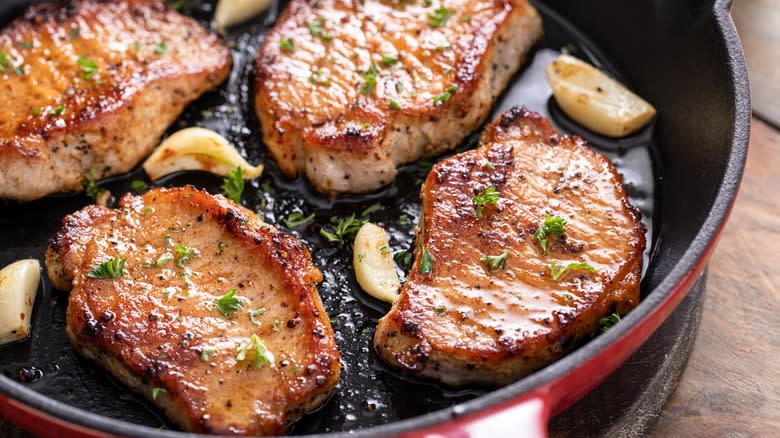
Cooking pork in a cold skillet can seem like sacrilege, not least because the thought of lukewarm, undercooked meat isn't exactly anyone's idea of a good time. However, cold-searing your pork chops is an exciting way to keep them juicy and flavorful. To cold-sear a pork chop, first pat it dry and then place it in a cold skillet. Then, crank the heat up to high, searing it on each side for a few minutes, before reducing the heat and letting the meat cook through gently.
Doing this sounds a little complicated, but it yields a premium result. When you cold-sear a pork chop, you avoid the meat contracting when it hits a hot pan, which can make the pork tough and chewy and force its moisture out. This is especially likely to happen with pork chops due to their relative leanness, and with barely any interior fat to lubricate the proteins, you're left with a mealy piece of meat. By cold-searing them, you develop a browned, flavorful exterior, while keeping the inside moist.
Omelets
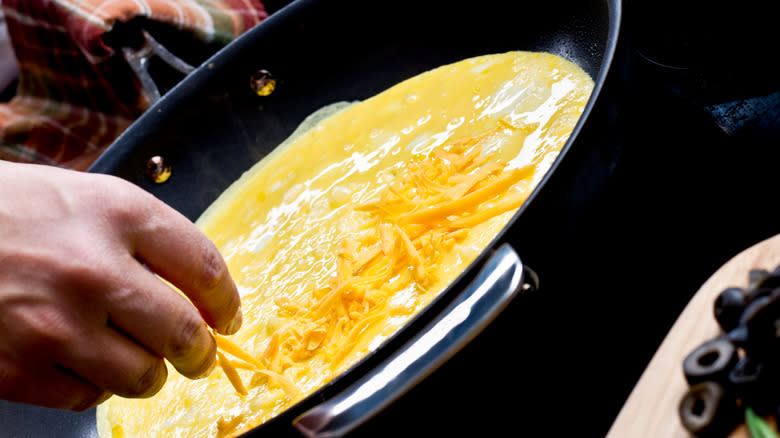
There are probably more opinions on how to cook omelets than any other recipe in existence. We think we've discovered our favorite technique, though, with a little help from Cyrille Holota. "Omelets, starting with a cold skillet allows more control over the cooking and prevents the eggs from overcooking too quickly," Holota says. "This will give you a tender and fluffy omelet with a creamy texture." Which is what we're all looking for, right?
Omelets, like other egg dishes, can react dramatically to high heat. When egg proteins interact with hot temperatures, they bond together and firm up, and the more you heat them, the tougher they get. High heat can also push the moisture out of eggs and their proteins, making your flash-fried omelet super dry. A lower temperature, conversely, will keep your eggs fork-tender and juicy. You can use pretty much any pan for this cold skillet method, but we'd recommend making your life easier by using a nonstick variety, which will keep your eggs from adhering to the pan as they slowly heat up.
Spices
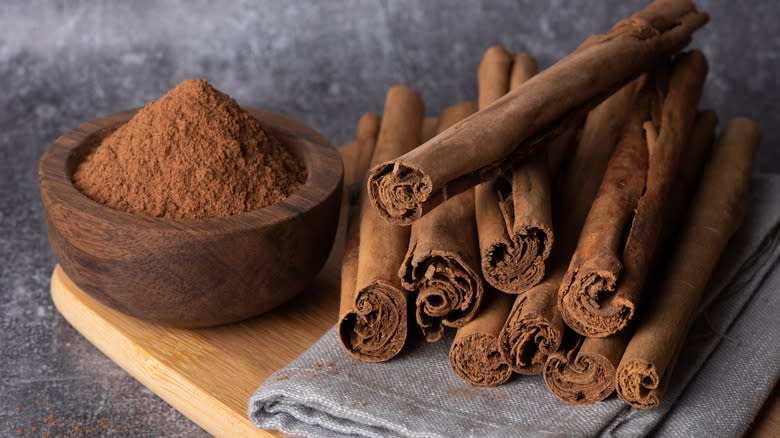
Burning spices can make them pretty gross and give them an acrid, charred flavor that ruins your cumin-flavored potatoes. That's why you should always start with a cold pan instead of a hot one. Both whole and ground spices can burn very quickly, thanks to their low water content and tiny surface area, even when there's sufficient oil. Rather than have this happen, start with a cold skillet and cold oil and gradually heat your spices to unlock their flavor slowly.
This method is especially useful for foods that benefit from sautéing whole spices first, like curries that contain mustard or cumin seeds. It's also a good idea to use this method when you're cooking fresh and dried herbs, which suffer from the same moisture and surface area issues as spices and have a propensity to burn rapidly. A good way to make the most of your aromatics' flavors is to cook them in a separate cold skillet in plenty of oil and then add them to your main dish toward the end of the process. This is a common method in some Indian recipes like dal tadka, with the tadka being a spice-infused, flavorful oil added just before serving.
Bacon
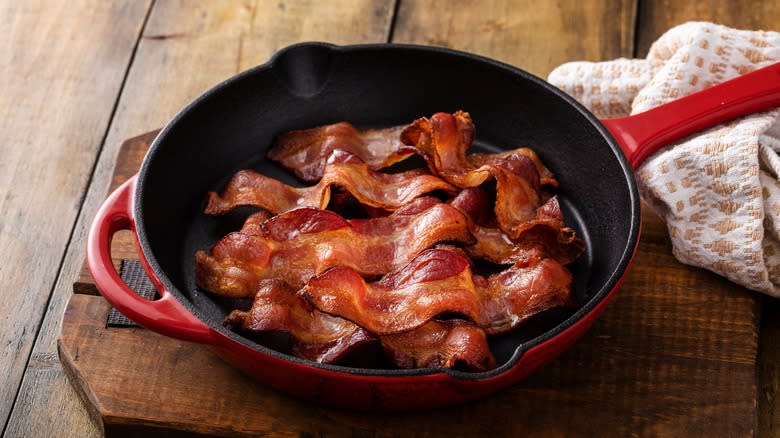
The thought of cooking bacon in anything but a hot pan can seem pretty wild, so it might shock you to hear that it's pretty much the best way of making it, especially when it's thick-cut. "Starting with a cold skillet when cooking a thick slice or cubes called lardons of bacon allows the fat to slowly melt, resulting in crispy evenly cooked bacon," says Cyrille Holota. "This method prevents the bacon from becoming overly crisp or burnt on the outside while still undercooked on the inside."
Holota also notes that cooking bacon slowly, starting with a cold skillet, helps its fat render out. This process essentially pulls the fat from the meat tissues, turning it from a solid substance into liquid bacon fat that pools in your pan. When you do this at a low, even temperature, your bacon turns from being chewy to crisp, instead of ending up with flabby, burnt pieces of fat on the outside of the meat. The best part, too, is that cooking bacon with a cold skillet requires little, if any fat. As the bacon heats up and the fat is released, it gently lubricates your meat.
Skin-On Chicken
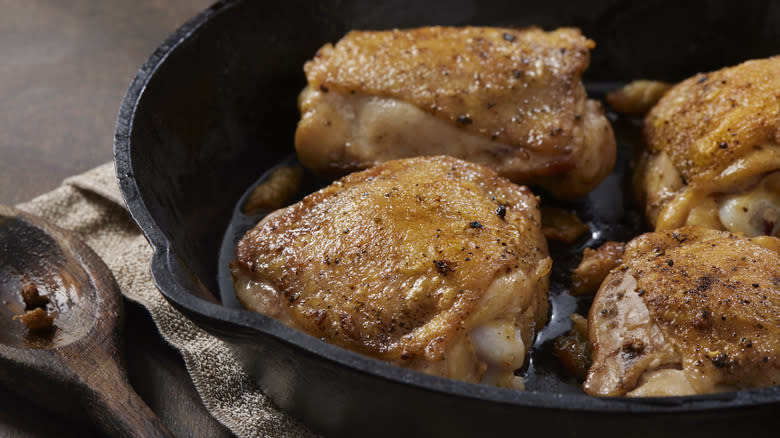
Getting crispy skin for your chicken in a skillet can be pretty challenging. Most people assume that the way to do this is to sear the skin at a high temperature straight off the bat. Unfortunately, though, this leads to the skin burning on the outside while remaining chewy underneath and the chicken flesh often being undercooked.
A far better method is to start with a cold skillet. You start by seasoning your chicken with some sea salt before placing it skin-side down in your oiled skillet and setting your heat to medium. Then, take a heavy pot (that's been cleaned on its underside) and place it directly on top of the chicken. This usually works better with boneless chicken pieces, so you don't have to worry about the pot not being level. Leave the whole thing to come up to temperature slowly, allowing the chicken skin to sizzle away before flipping it.
This method has roots in classic French cooking techniques and produces results similar to cooking bacon using a cold skillet, through the process of rendering. Chicken skin is high in fat, and when you gently bring it up to temperature, this fat leaks out. The chicken skin is left super-crisp, and the chicken remains moist and juicy.
Steak
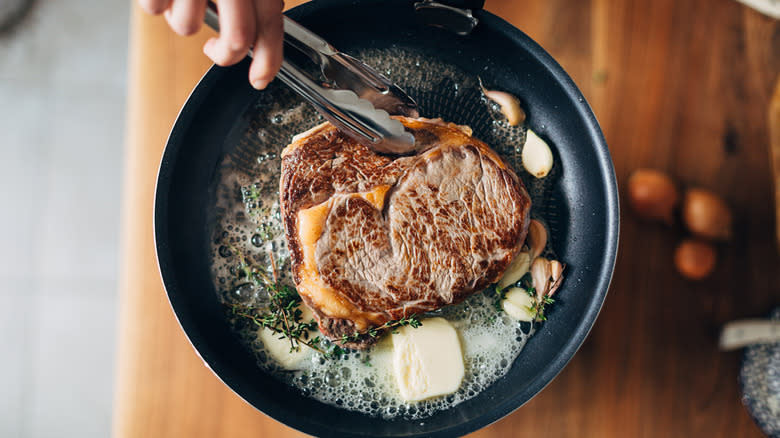
Steak and cold skillets don't seem like they go together -- and for many chefs, suggesting you start your meat in a chilly pan would raise some fears. Not for Cyrille Holota, though. "Most chefs like to start their steak ... in a very hot skillet to char the meat very hard," Holota says. "I always start my 14-ounce prime New York steak in a cold skillet."
The reason Holota does this is to ensure an even cook throughout. "By starting in a cold skillet, the heat will go evenly inside the meat and have a beautiful caramelization of the surface," he explains. You'll end up with a crispy, browned outside and tender meat within.
Using this method takes a little bit of timing, though. You begin with your cold pan, placing your room-temperature steak inside it and then flipping the heat to high. Allow it to cook for two minutes on one side before flipping it and searing it for the same amount of time on the other side. Then, turn your heat down to medium and continue flipping it every two minutes until its internal temperature reads around 120 degrees Fahrenheit, which will give you a medium-rare result. Once your steak is done, Holota suggests that you deglaze your pan with a little brandy and produce a gorgeous peppercorn sauce.
Grilled Cheese
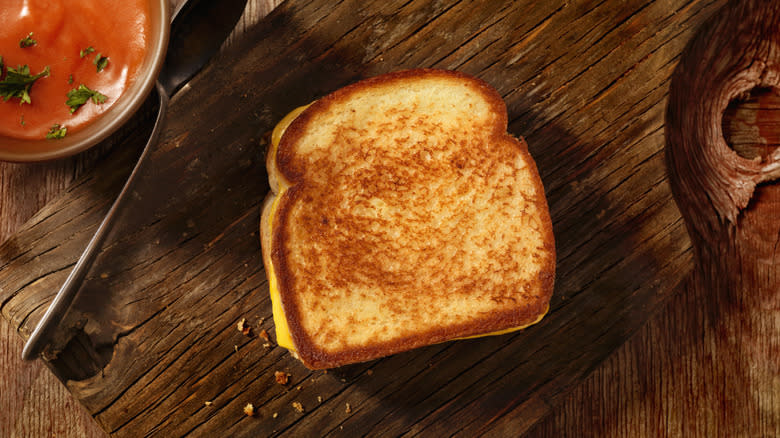
Grilled cheese sandwiches can either be totally delicious or deeply disappointing, and the latter occurs when they don't cook all the way through. When you cook your grilled cheese in a hot skillet, the bread can toast before the heat has a chance to permeate to its interior. This can leave you with a pretty disastrous choice: You either continue to cook your grilled cheese, burning the outside, or you put up with lumps of chewy, cold cheese.
Starting with a cold skillet helps you avoid all of that. By bringing your grilled cheese up to temperature slowly, the heat has ample time to get to its innermost points. Don't worry about your bread, either: It'll still toast beautifully, giving you a super crispy grilled cheese sandwich that's full of unctuous cheese. Just bear in mind that the way you prepare your grilled cheese can influence its success, even when using a cold skillet. Make sure your bread isn't too thick, or too crusty, as both of these can prevent the heat from getting inside it properly. Don't slice your cheese too thick, either: The thinner it is, the quicker it'll melt.
Mornay Sauce
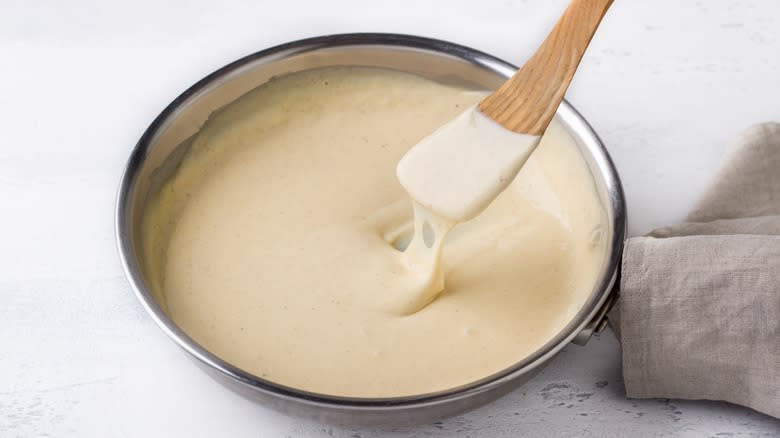
Mornay sauce is a staple of French cuisine. Considered one of the "mother sauces," it is, in some respects, an upgraded béchamel sauce, taking that classic base (which is, incidentally, a mother sauce of its own) and adding mountains of cheese to it. Whatever cheese you're choosing to make your mornay, though, you should always start with a cold skillet. Using one "will help and prevent [the mornay sauce] from burning on the bottom of your pot and ensure a smooth texture," says Cyrille Holota.
The problem with using a hot skillet to start a mornay (or béchamel) sauce is that it's full of ingredients that can burn quickly. Butter, with its high proportion of milk solids, has a propensity to catch on the bottom of your pan and scorch fast. Whole milk does the same, while flour, with its minimal moisture content, can blacken before you know it. Using a cold skillet allows you to control the temperature with way more precision and gives the ingredients time to gently heat up, which produces that classic thickness. Keeping the temperature low also gives your cheese a chance to melt slowly, producing the smooth consistency we all crave.
Shrimp
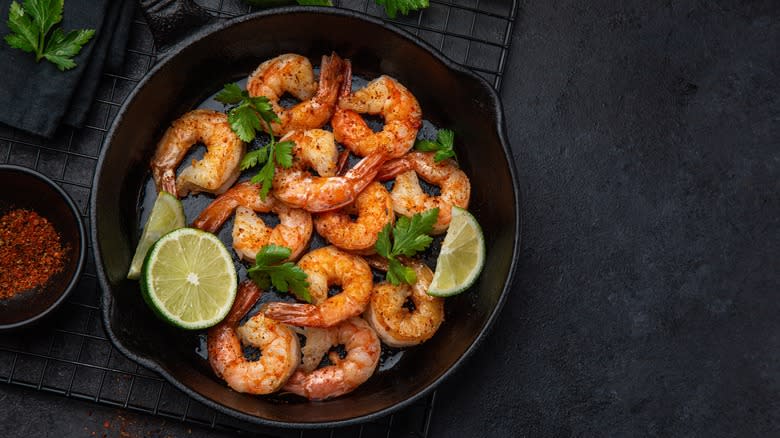
Keeping shrimp juicy is an endless struggle. Because they're so tiny, they can go from moist and tender to rubbery in just a few seconds. This can be easily avoided by starting them off in a cold skillet. By putting them in a cold pan and then turning to heat to high, the shrimp cook gently while lightly browning on the outside. This stops them from seizing up and keeps them plump and full of flavor.
To make this method foolproof every time, there are a few additional steps you should take. Instead of oiling your pan, pour oil over your shrimp and toss them. This gets oil into every nook and cranny and gives the shrimp an adequate coating, which you just don't get if you're oiling your pan first. Coating them in a little sugar can also help them develop a beautifully brown, caramelized crust. (Make sure not to go overboard here, though -- shrimp flesh is already a little sweet, and you don't want to make them into candy.) It's also a good idea to take your pan off the heat when you flip your shrimp over, to allow the residual heat to cook them. Leaving them on the burner can make them way too tough.
Salmon
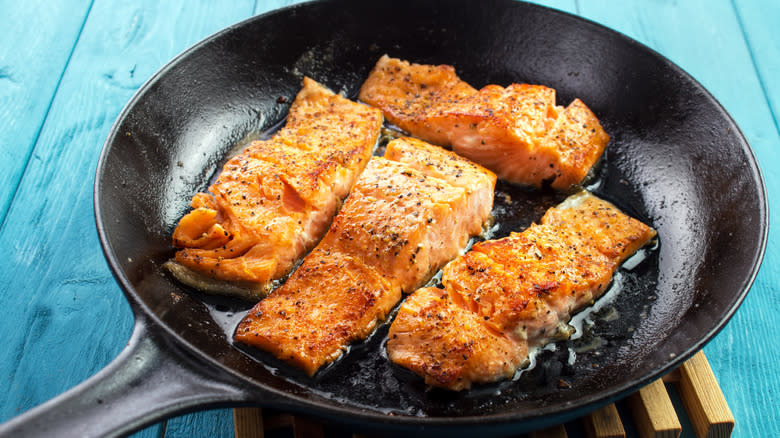
Salmon, like all fish, can turn from moist to flaky and dry pretty quickly. While salmon is slightly better at staying lubricated, thanks to its high fat content, it can still lose its buttery texture fast when it's plopped into a hot skillet. Using a cold skillet is the best way to avoid this. When you start your salmon in a cold skillet, everything heats up gently, slowly cooking the flesh without causing it to become too tense. It's a similar principle to baking salmon in foil, which heats the fish gently and locks in its moisture.
This is an excellent method whether you're cooking skinless or skin-on salmon -- but if it's the latter, you'll especially want to use a cold pan. Salmon skin contains a high concentration of the fish's all-important omega-3 fatty acids (the reason being that it acts as an insulator for the fish when it's in cold waters). When you cook the fish slowly, that fat can render away, leaving the skin crispy. Cook it too quickly, and you'll find that the salmon skin remains gummy and unappetizing.
Read the original article on Daily Meal

